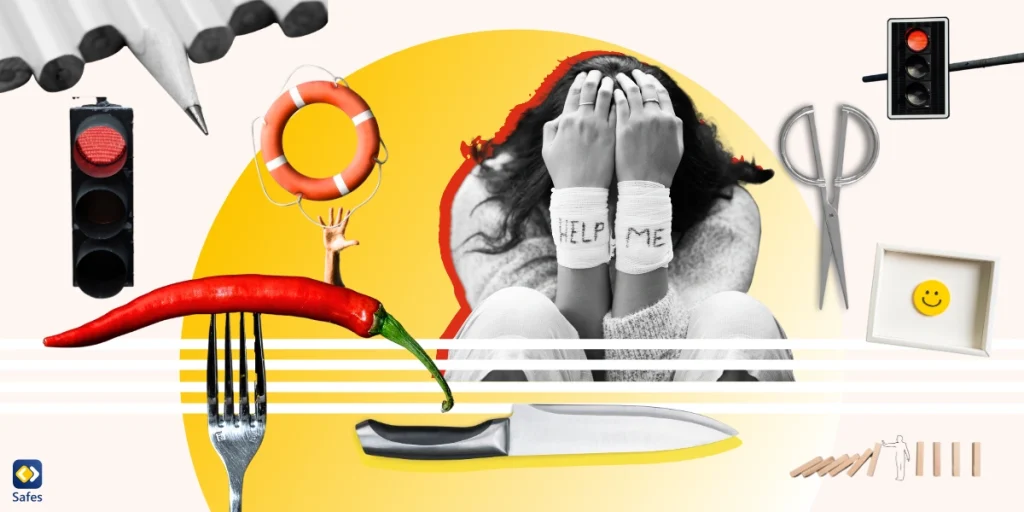It’s critical for parents to be educated on the sensitive subject of self-harm in children. Learning that your child is participating in self-harm can be upsetting, but it’s crucial to learn more about it to handle the situation. By showing compassion, empathy, and support parents can guide their children through their emotions and learn to handle them in a gentler way. In this digital age, technology can possibly cause self-harm in children. The purpose of this blog is to emphasize the significance of understanding self-harm in children and to discuss the role of technology in preventing and controlling self-harming behaviors.
Understanding Self-Harm in Children
If you’re suspecting that your child is self-harming, it might be helpful to understand self-harm in children better. Let’s look at the definition of self-harm, the types, and the prevalence.
Definition of Self-Harm
Self-harm is usually not intended as a result of a suicidal gesture. It’s rather used as a coping mechanism for dealing with overwhelming feelings. Self-harm is a complex issue often associated with underlying mental health conditions such as depression, anxiety, borderline personality disorder, or eating disorders.
Types of Self-Harm
Self-harm can take various forms, and individuals may engage in one or multiple methods. It’s important to note that discussing specific self-harm methods can be triggering for some individuals. Nonetheless, it’s important to have a general understanding of the different types:
- Cutting or Laceration: This is the most common form of self-harm. It involves using sharp objects such as knives, razor blades, or broken glass to create cuts or scratches on the skin.
- Burning: Burning oneself with cigarettes, lighters, matches, or other hot objects is another method of self-harm. This can result in visible burns or blisters.
- Biting or Scratching: Some individuals may engage in biting or scratching their skin to cause injury. This can leave marks or bruises.
- Hitting or Punching: Inflicting physical harm by hitting or punching oneself, often targeting specific body parts, is another form of self-harm.
- Hair Pulling: Known as trichotillomania, this involves pulling out one’s hair, often in response to stress or anxiety. It can result in noticeable hair loss or bald patches.
- Interfering with Wound Healing: Some individuals may pick at or reopen existing wounds, preventing them from healing properly.
- Ingesting Harmful Substances: Ingesting toxic substances or excessive amounts of medication with the intention of causing harm to oneself is a dangerous form of self-harm.
It’s important to remember that self-harm is not limited to these methods and can manifest in other ways. Some individuals may engage in less visible forms of self-harm, such as excessive scratching, hitting objects, or engaging in risky behaviors that put their safety at risk.
Prevalence and Common Age Groups Affected by Self-Harm
Self-harm is a serious issue that can affect individuals across various age groups. While it can occur at any age, it often emerges during adolescence and young adulthood. Let’s look at some key points regarding the prevalence and age groups affected by self-harm.
- Adolescents and Young Adults: Self-harm is most prevalent among adolescents and young adults. The mean age of starting self-harm in children is shown to be 13 years old. So, if you have a 13-year-old, it might help you to pay extra attention to them.
- Gender Differences: Self-harm can affect all genders. The same research as mentioned above, suggests that girls may be more likely to engage in self-harm compared to boys. This gender difference is not definite and can vary depending on cultural, social, and individual factors.
- Risk Factors: Several risk factors may contribute to the development of self-harming behaviors, including mental health conditions. Other factors can include a history of trauma, difficulties in emotion regulation, low self-esteem, and social isolation.
- Vulnerable Populations: Certain populations may be at higher risk for self-harm. For example, individuals who identify as LGBTQ+ may face unique stressors and experiences that can contribute to self-harming behaviors. Additionally, individuals with a history of childhood abuse, neglect, or adverse life events may be more susceptible to self-harm.
Research on the link between ADHD and self-harm in children has shown that the self-harm sample had considerably higher ADHD/hyperactivity ratings. The researchers recommend that clinicians evaluating adolescents who have self-harmed be aware of suspected ADHD symptoms and screen as needed.
Seeking Help
Regardless of age, early intervention and appropriate support are crucial for individuals who engage in self-harming. Encouraging open communication, reducing stigma, and providing access to mental health resources are essential steps in addressing self-harm across all age groups.
Recognizing Signs of Self-Harm
To recognize self-harm in children it’s important to learn about the indicators and signs. Self-harm can have physical, behavioral, and emotional indicators.
Physical Signs and Symptoms
Some of the physical signs that you should look out for in your child are:
- Self-harm often manifests in visible marks on a child’s body. Understanding these signs is crucial for early intervention.
- Unexplained cuts, scars, burns, or bruises may indicate self-harming behavior.
- Changes in clothing preferences, such as wearing long sleeves in warmer weather, may be an attempt to conceal injuries.
Behavioral and Emotional Indicators
To be aware of the behavioral signs of self-harm in children, we’re going to name some of them. However behavioral and emotional indicators are a bit tricky since children can learn to mask them.
- Children who engage in self-harm may often withdraw from social activities and isolate themselves.
- A sudden decline in academic performance, loss of interest in hobbies, or an overall change in demeanor could indicate distress.

How Can Parents Help?
Parents play an important role in helping their children when they notice signs of self-harm.
Educate Themselves
It’s important that parents take the time to educate themselves about self-harm. Read reliable resources, consult mental health professionals, and seek support from relevant organizations. Understanding self-harm will enable you to approach the situation with empathy and knowledge.
Create a Safe and Supportive Environment
Maintain a safe and non-judgmental environment for your child to express their feelings. Encourage open conversations about emotions, stressors, and challenges. Make sure they know they can trust you and that seeking help is a sign of strength, not weakness.
Supporting a child who engages in self-harm can be challenging, but it’s essential to be patient, understanding, and non-judgmental. Avoid blaming or criticizing your child. Instead, express your concern, love, and willingness to help them through their struggles.
Foster Emotional Well-being
Teach your child healthy coping mechanisms for managing stress and emotions. Encourage them to engage in activities they enjoy. Encourage the development of strong relationships and a support network.
The Role of Technology Use in Self-Harm
Technology can both contribute to and help prevent self-harm. By monitoring your child’s device use and being aware of the platforms and apps they are using, you can help minimize technology’s effect on your child’s mental health. Educate yourself about potential online risks, cyberbullying, and self-harm content. Encourage responsible use of technology and establish healthy boundaries.
Consider implementing parental controls and monitoring software on your child’s devices. These tools can help you keep an eye on their online activities, block harmful content, and receive alerts if keywords or behaviors are detected. If your child is searching for self-harm or otherwise worrying content, you can be on top of it in no time.
Teach your child about online safety, privacy, and responsible digital citizenship. Discuss the potential dangers of sharing personal information, interacting with strangers online, and engaging in harmful online communities. Encourage them to report any concerning content or behavior they come across.
Seek Professional Help
If you suspect or discover that your child is self-harming, it’s crucial to seek professional help. Consult experienced in working with children and adolescents. They can provide a comprehensive assessment, develop a treatment plan, and offer strategies for managing self-harming behaviors.
Encourage and Participate in Treatment
Actively support your child’s treatment process. Attending therapy sessions, follow through with recommended interventions, and encourage healthy habits. Reinforce positive progress and remind your child that they are not alone in their journey towards healing.

Conclusion
Understanding child self-harm is critical for parents. Parents may play an important part in avoiding and controlling self-harming behaviors by educating themselves, creating a supportive atmosphere, monitoring technology use, and getting professional help when necessary. Remember that not only parents, but also peers and teachers can help by showing love, understanding, and support to make a big difference in children’s lives.




